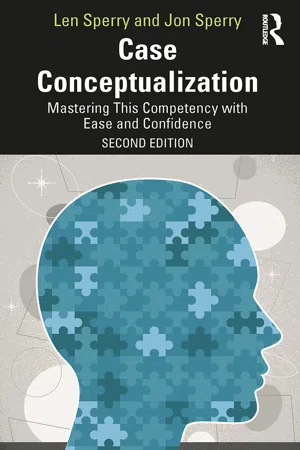
Case Conceptualization
Mastering This Competency with Ease and Confidence
- 235 pages
- English
- ePUB (mobile friendly)
- Available on iOS & Android
About this book
Integrating recent research and developments in the field, this revised second edition introduces an easy-to-master strategy for developing and writing culturally sensitive case conceptualizations and treatment plans.
Concrete guidelines and updated case material are provided for developing conceptualizations for the five most common therapy models: Cognitive-Behavioral Therapy (CBT), Psychodynamic, Biopsychosocial, Adlerian, and Acceptance and Commitment Therapy. The chapters also include specific exercises and activities for mastering case conceptualization and related competencies and skills. Also new to this edition is a chapter on couple and family case conceptualizations, and an emphasis throughout on trauma.
Practitioners, as well as graduate students in counseling and in clinical psychology, will gain the essential skills and knowledge they need to master case conceptualizations.
Frequently asked questions
- Essential is ideal for learners and professionals who enjoy exploring a wide range of subjects. Access the Essential Library with 800,000+ trusted titles and best-sellers across business, personal growth, and the humanities. Includes unlimited reading time and Standard Read Aloud voice.
- Complete: Perfect for advanced learners and researchers needing full, unrestricted access. Unlock 1.4M+ books across hundreds of subjects, including academic and specialized titles. The Complete Plan also includes advanced features like Premium Read Aloud and Research Assistant.
Please note we cannot support devices running on iOS 13 and Android 7 or earlier. Learn more about using the app.
Information
Introduction to the Chapters in Part I
1 Case Conceptualizations
Case Conceptualization: Definition and Functions
- 1. Obtaining and organizing. The case conceptualization process begins with the first client contact and formulating tentative hypotheses about the client’s presentation, expectations, and dynamics. These hypotheses are continually tested out while performing an integrative assessment guided by a search for patterns – maladaptive patterns – in the client’s current and past life with regard to precipitants and predisposing and perpetuating factors.
- 2. Explaining. As the contours of the client’s maladaptive pattern come into focus and hypotheses are refined, a diagnostic, clinical, and cultural formulation emerges. Within these formulations is a likely explanation of the factors that account for the client’s reactions in the past, the present, and the future without treatment. This explanation also provides a rationale for treatment that is tailored to the client’s needs, expectations, culture, and personality dynamics.
- 3. Guiding and focusing treatment. Based on this explanation, a treatment formulation emerges, and strategies for specifying treatment targets and for focusing and implementing treatment are developed.
- 4. Anticipating obstacles and challenges. One test of an effective case conceptualization is its viability in predicting the most likely obstacles and challenges throughout the stages of therapy, particularly those involving active engagement in and commitments to the treatment process, adherence, resistance, ambivalence, alliance ruptures, transference enactments, relapse, and termination.
- 5. Preparing for termination. The case conceptualization also assists therapists to recognize when the most important therapy goals and treatment targets have been addressed and to identify when and how to prepare for termination (Cucciare & O’Donohue, 2008). The process of terminating treatment can be quite stressful for some clients, particularly those with dependency issues, rejection sensitivity, and abandonment histories. Therefore, an effectively constructed case conceptualization which anticipates these considerations can be immensely useful in preparing the client for termination (Sperry, 2010).
Clinically Useful Case Conceptualizations
Version 1
Table of contents
- Cover
- Endorsements
- Half-Title
- Title
- Copyright
- Contents
- Foreword
- Acknowledgments
- Introduction
- Introduction to the Chapters in Part I
- Part II
- Appendix: Forms
- Index